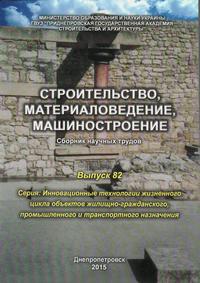Given the intensity in plasners under the influence of temperature deformation of the system "GAZOBETON MASONRY-PLASTERS" the design of the plasner solutions
Keywords:
сriteria for assigning properties plaster, masonry of autoclaved aerated concrete, plaster coating for atoklavnogo aeratedAbstract
Purpose. To develop criteria for setting of properties and selection of composition of clout solutions of primenyaemykh for laying, executed from an autoclave aerocrete. Planning of compositions and properties, clout solutions it is necessary to conduct taking into account one of basic criteria-tensions of arising up clout coverage from his usadki and difference of deformations with laying at hardening, and also deformations of a wall construction and coverage during exploitation. It is necessary to provide such level of tensions in clout coverage and contact area to the sizes, less, than destroying. Method. Results are got by the calculation of tensions in clout coverage through formulas, programs «Ansis», «Lira» and the twofactor planned experiment with the use of the system of COMPEX 2000, on the basis of experimental and literary information of fiziko-mechanical descriptions of the gazobetonnoy laying and clout solutions. Results. Findings confirm that one of basic criteria at setting of properties and compositions of clout solutions, there must be tensions in clout coverage. Scientific novelty. The development of ideas about the criteria under which properties should be appointed and designed compositions plaster masonry of autoclaved aerated concrete. The practical significance. The criteria on the basis of which you want to assign properties and design compositions plaster masonry of autoclaved aerated concrete.References
Paruta VA Features of technology of construction and exploitation is the outer walls of the AAC / Paruta VA Semin Yuri, Joiner EA Ustenko AV Brynzin EV // Building materials, equipment, 21st century technology, №12, Moscow, 2012, C. 35-39.
Granau E. Warning defects in build-enforcement structures. Moscow. Stroyizdat. Moscow 1980 p.217.
Sazhneva NN, NP Sazhnev, Uretskaya EA ProtectionWIDE system for finishing cellular concrete in reduced density // Building materials. 2009. №1. S. 17-19.
Halimov RK Research collaboration build-ing materials as part of today's multi-layer thermal efficiency of external walls of buildings, thesis for the degree of candidate of technical sciences, specialty: 05,23.05 - Construction materials and from Delia; Ufa, 2007. 178p.
J. Paplavskis, A.Frosh, requirements plaster compositions for exterior decoration of walls from cellular concrete. SPb .: Publishing House. Polytechnic University, 2010 S.10-15.
Struble L. Microstructure and Fracture at the Cement Paste-Aggregate Interface. //Bond. Cementitious Cmpos.: Symp., Boston, Mass., Dec.2-4, 1987. -Pittsburgh (Pa), -1988. -pp.11-20.
Galkin SL, Sazhnev NP Sokolovsky LV Sazhneva NN;The use of cellular concrete products. Theory and Practice &, Minsk, 2006, 448s.
Powers T.S. A Hypothesis on carbonation shrinkage. Journal of Portland Cevent Association. –Research Development Laboratoru. 1962, v.4, No.2.pp.26-31.
Vasicek J. Trvanlivost aodolnost autoklavovanych porovitych betonu pri posobeni susnych vnejsich jevu. –Stavivo, 1965. № 6.,pp.24-28.
M. Homann. Richtig Bauen mit Porenbeton. Stuttgart, 2003., 268p.
Downloads
Issue
Section
License
Редакція Видання категорично засуджує прояви плагіату в статтях та вживає всіх можливих заходів для його недопущення. Плагіат розглядається як форма порушення авторських прав і наукової етики.
При виявлені у статті більш ніж 25% запозиченого тексту без відповідних посилань та використання лапок, стаття кваліфікується як така, що містить плагіат. У цьому випадку стаття більше не розглядається редакцією, а автор отримує перше попередження.
Автори, в статтях яких повторно виявлено плагіат, не зможуть публікуватися в усіх журналах Видавництва ДВНЗ «Придніпровська державна академія будівництва та архітектури».
Автори, які публікуються у цьому журналі, погоджуються з наступними умовами:
- Автори залишають за собою право на авторство своєї роботи та передають журналу право першої публікації цієї роботи на умовах ліцензії Creative Commons Attribution License, котра дозволяє іншим особам вільно розповсюджувати опубліковану роботу з обов'язковим посиланням на авторів оригінальної роботи та першу публікацію роботи у цьому журналі.
- Автори мають право укладати самостійні додаткові угоди щодо неексклюзивного розповсюдження роботи у тому вигляді, в якому вона була опублікована цим журналом (наприклад, розміщувати роботу в електронному сховищі установи або публікувати у складі монографії), за умови збереження посилання на першу публікацію роботи у цьому журналі.
- Політика журналу дозволяє і заохочує розміщення авторами в мережі Інтернет (наприклад, у сховищах установ або на особистих веб-сайтах) рукопису роботи, як до подання цього рукопису до редакції, так і під час його редакційного опрацювання, оскільки це сприяє виникненню продуктивної наукової дискусії та позитивно позначається на оперативності та динаміці цитування опублікованої роботи (див. The Effect of Open Access).

